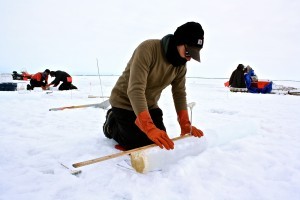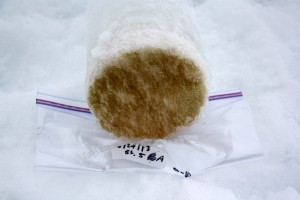A Tale of Sea Ice, Algae and the Arctic
I returned to New York on Monday, but Lamont-Doherty Earth Observatory scientists Andy Juhl and Craig Aumack remain working in Barrow, Alaska for another week. They’ll continue to collect data and samples in a race against deteriorating Arctic sea ice conditions as the onset of summer causes the ice to thin and break up.

I returned to New York on Monday, but Lamont-Doherty Earth Observatory scientists Andy Juhl and Craig Aumack remain working in Barrow, Alaska for another week. They’ll continue to collect data and samples in a race against deteriorating Arctic sea ice conditions as the onset of summer causes the ice to thin and break up. Even in the two weeks I stayed in Barrow the ice changed dramatically, shifting from a snow-covered ice pack to a nearly snow-free ice pack, covered in cracks and increasingly large melt ponds. An animation from the May 23 Barrow sea ice radar reveals just how quickly shorefast sea ice can change. Soon the ice will be deemed unsafe for travel by snow machine and spring fieldwork conducted on the ice will end.
Our team’s research in Barrow is just one part in the long process of studying and answering questions about algae growing in and under Arctic sea ice and its role in the marine ecosystem. And, it’s a process that does not necessarily have a defined end — investigating the natural world always leads to more questions. From fieldwork, where observations are made and data gathered, new questions arise, new hypotheses are put forward and new ways of collecting data are developed. This work leads to further experiments where new data and samples are collected, observations are made, analyses performed and results interpreted. Some of the findings will challenge existing hypotheses, leading to their modification, which starts the research process over again.

Fieldwork gives scientists the opportunity to observe systems in a holistic way, leading to new insight and further research questions; each piece of data causes a rethinking of ideas and expectations for future results. “Fieldwork is inspiring and it’s critical to the creative process for environmental science because you often see things that you don’t necessarily see in your data,” said Andy. “There are subtleties and patterns that you can pick on if you pay attention to observe the natural world. You can’t do that in the lab or by looking at numbers.”
Some people may be disappointed to learn that we don’t have many immediate answers about sea ice algae and the Arctic ecosystem based on our month of Barrow fieldwork. But, scientists don’t set out to study things that are already understood or to answer questions that already have answers, and it takes time to unravel Earth’s mysteries. On this trip, project scientists discovered and collected lots of algae, observed novel behavior by marine organisms in the water column and on the seafloor, and gathered lots of data. The next steps in this project are to analyze the samples and data collected in Barrow, interpret these, write up findings and report these in journals and at scientific meetings. And, in 2014, Andy and Craig will return to Barrow to continue their study of sea ice algae, armed with new understanding of the algae, as well as new research questions to explore.

The goal of our project is to understand how ice algae functions and its role in the marine ecosystem, but we’ve received many questions about how ice algae, the residents of Barrow and the rest of life in the Arctic will be affected by a climate that is undoubtedly and irrevocably changing. The answer is that we don’t know, but our research may contribute to future understanding of these issues. Though the Arctic is changing faster than anywhere else on the planet, with temperature increasing and ice volume decreasing, it is still one of the least explored places on Earth. In order to know how climate change will impact this region, the basic oceanographic and ecological processes must first be understood.
As our project progresses, we’ll continue to provide updates and look forward to sharing a video of our time in Barrow that’s being produced by our friends at Climate Science TV. For more information on this research project, visit http://lifeintheice.wordpress.com. Our colleagues at Lamont-Doherty Earth Observatory also travel the world exploring our planet; to keep up with more interesting Earth science research and reports from the field, follow Lamont-Doherty on Twitter and Facebook.
And thanks to everyone who followed our expedition, we enjoyed sharing it with you!
